Monthly Features Archive
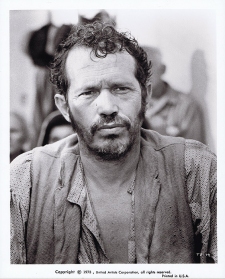 CULT
HOLLYWOOD HEROES: CULT
HOLLYWOOD HEROES:
Warren Oates
1928-1982
Best known for his performances in the films of Sam
Peckinpah, Warren Oates carved out a memorable career
playing a variety of offbeat roles with an astonishing
range. Relegated to supporting roles for the most part, he
landed starring roles in a number of 1970s films such as
"Bring Me the Head of Alfredo Garcia" and "Two Lane
Blacktop" that have assured him of something more than cult
status. Today, the actor is remembered for his wide range of
colorful outsider characters. His uncommon, alternately
crude and loveable persona is admired by directors such as
Quentin Tarrantino and Richard Linklater.

Warren Mercer Oates was born in rural Kentucky in 1928,
where his father owned a general store. He began his acting
career in the Mid-1950s after a stint in the Marines. For
six years he appeared in a variety of television shows
including "Playhouse 90," "Have Gun Will Travel" and "Wagon
Train." While working on the television on show "The
Rifleman" he met director Sam Peckinpah who was also serving
his apprenticeship. With the popularity of the western
feature beginning to fade, Peckinpah would direct one of the
last great westerns of the classic era, "Ride the High
Country" in 1962, giving Oates a defining role as one of the
scurvy Hammond brothers. Oates would go on to appear in
three more of his films including "The Wild Bunch" and
"Major Dundee".

In addition to his acting for Peckinpah, Oates worked with
many other top directors of the era, including Joseph L.
Mankiewicz in "There Was a Crooked Man," Terence Mallick in
"Badlands" and Norman Jewison in "In the Heat of the Night",
memorably playing a racist police officer. He then went on
to a brief career as a l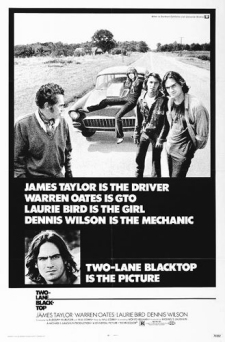 eading
man in film such as "Dillinger," "Race With the Devil" and "Cockfighter."
"Two Lane Blacktop," a film by frequent collaborator Monte
Hellman, was a box office disappointment at the time, but
has since become a cult favorite in a large part due to
Oates performance as an aging hot rodder. His final years
found him working in "A" budget films with directors like
Stephen Spielberg ("1941") and Ivan Reitman ("Stripes"). eading
man in film such as "Dillinger," "Race With the Devil" and "Cockfighter."
"Two Lane Blacktop," a film by frequent collaborator Monte
Hellman, was a box office disappointment at the time, but
has since become a cult favorite in a large part due to
Oates performance as an aging hot rodder. His final years
found him working in "A" budget films with directors like
Stephen Spielberg ("1941") and Ivan Reitman ("Stripes").
Oates died of a heart attack in 1982; his final movies
released posthumously. Today, the actor is remembered for
his wide range of colorful outsider characters.
James Cagney
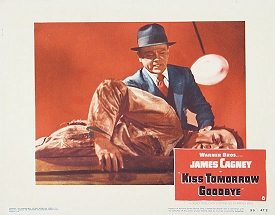 Of
all his movies, perhaps surprisingly, Cagney’s favorite was
Yankee Doodle Dandy (1942). The urban-centric, rough-necked
image portrayed in his gangster movies was in fact, unlike
him. “Though I soon became typecast in Hollywood as a
gangster and hoodlum, I was originally a dancer, an Irish
hoofer, trained in vaudeville tap dance. I always leapt at
the opportunity to dance in films later on.” He spent as
much time as possible on his farm, away from the bright
lights of Hollywood; someone more comfortable with a shovel
in hand than a pistol. This, if anything, makes his
convincing hoodlum manner all the more impressive. Of
all his movies, perhaps surprisingly, Cagney’s favorite was
Yankee Doodle Dandy (1942). The urban-centric, rough-necked
image portrayed in his gangster movies was in fact, unlike
him. “Though I soon became typecast in Hollywood as a
gangster and hoodlum, I was originally a dancer, an Irish
hoofer, trained in vaudeville tap dance. I always leapt at
the opportunity to dance in films later on.” He spent as
much time as possible on his farm, away from the bright
lights of Hollywood; someone more comfortable with a shovel
in hand than a pistol. This, if anything, makes his
convincing hoodlum manner all the more impressive.
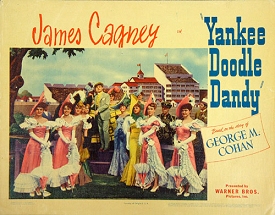 Somewhat
more bizarrely, he was only forced into doing the patriotic
sing-a-long because of accusations made claiming he was a
communist. The controversy caused him to do everything in
his power to make a film that would convince people once and
for all where his heart lay. This for Cagney was pure luck.
He quickly shook the shackles of his stellar performance in
The Public Enemy. After years of sharp shooting and hanging
out with the filthy deadbeats of society, Cagney was in his
element: singing and dancing. Somewhat
more bizarrely, he was only forced into doing the patriotic
sing-a-long because of accusations made claiming he was a
communist. The controversy caused him to do everything in
his power to make a film that would convince people once and
for all where his heart lay. This for Cagney was pure luck.
He quickly shook the shackles of his stellar performance in
The Public Enemy. After years of sharp shooting and hanging
out with the filthy deadbeats of society, Cagney was in his
element: singing and dancing.
He was always a pleasure to watch, an actor who used his
most powerful tool, his eyes, to
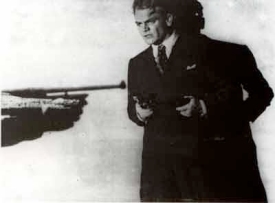 great
effect. Not since Peter Lorre had an audience been so
mesmerized. He had eyes that you would quickly glance away
from on the street, if you ever had the misfortune of
meeting them. However, as opposed to Lorre, the audience was
not filled with fear or suspense; rather, they were excited.
You knew whoever was in the lock of those eyes was surely
doomed, and you waited eagerly for that boom-boom-bang. I
always felt that Cagney was the kind of guy you would end up
thanking for slapping you in the face, probably out of
respect. He set the tone for Napoleonic angry men, who would
resurface at various intervals in the timeline of cinema;
famous examples being Al Pacino and Joe Pesci. great
effect. Not since Peter Lorre had an audience been so
mesmerized. He had eyes that you would quickly glance away
from on the street, if you ever had the misfortune of
meeting them. However, as opposed to Lorre, the audience was
not filled with fear or suspense; rather, they were excited.
You knew whoever was in the lock of those eyes was surely
doomed, and you waited eagerly for that boom-boom-bang. I
always felt that Cagney was the kind of guy you would end up
thanking for slapping you in the face, probably out of
respect. He set the tone for Napoleonic angry men, who would
resurface at various intervals in the timeline of cinema;
famous examples being Al Pacino and Joe Pesci.
Locations in Hollywood Cinema:
The Diner
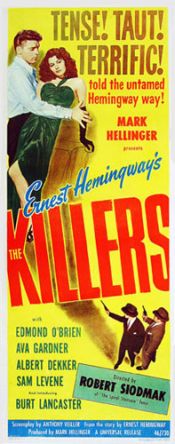 The
diner is a symbol of America. Its twenty-four hour nature
and endless menu symbolize the countries’ commitment to give
people as much freedom as possible to do as much of what
they please. It is not surprising then that cinema has
chosen the diner as a location that draws those who desire
to do exactly what they want, without concern for others.
Serial killers, punks, hoodlums and drunks, are but a few of
the patrons in any movie diner; sitting next to students,
teachers, miners and preachers. They choose this explicitly
public place, this icon of Americana, to leap from the
confines of normal social behavior. As the gathering place
for all of suburban America, the diner has been chosen
repeatedly in American cinema to reveal the countries’ more
sinister side. The
diner is a symbol of America. Its twenty-four hour nature
and endless menu symbolize the countries’ commitment to give
people as much freedom as possible to do as much of what
they please. It is not surprising then that cinema has
chosen the diner as a location that draws those who desire
to do exactly what they want, without concern for others.
Serial killers, punks, hoodlums and drunks, are but a few of
the patrons in any movie diner; sitting next to students,
teachers, miners and preachers. They choose this explicitly
public place, this icon of Americana, to leap from the
confines of normal social behavior. As the gathering place
for all of suburban America, the diner has been chosen
repeatedly in American cinema to reveal the countries’ more
sinister side.
The opening scene from 1946’s The Killers takes place in
a run-of-the-mill New Jersey diner. Two hired guns enter the
diner, disrespect the owner, tie and gag the cook and only
other customer, then wait guns at the ready, for a regular
patron to walk through the front door. As the killers sit
patiently the nonchalant regularity and calmness of their
actions seems to suggest that this occurrence could happen
on any given night at this diner, and not just this
Brentwood, NJ diner but any one of them across the country.
Because of their mundane feel
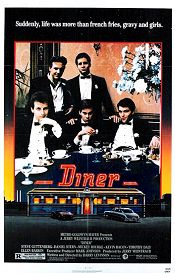 and
transferable itinerancy it is easy to see the diner as a
location of national symbolism. Their furniture is similar,
their waitresses dress alike, and they all have photos of
Buddy Holly on the wall. The collective dinginess of all
these establishments creates shadows for the dregs of
society to operate in; they are the playgrounds of society
before the bars open, and after the barman’s gone home. and
transferable itinerancy it is easy to see the diner as a
location of national symbolism. Their furniture is similar,
their waitresses dress alike, and they all have photos of
Buddy Holly on the wall. The collective dinginess of all
these establishments creates shadows for the dregs of
society to operate in; they are the playgrounds of society
before the bars open, and after the barman’s gone home.
Perhaps the high points of the diner’s role in cinema
comes when those social dregs step out the shadows and
disturb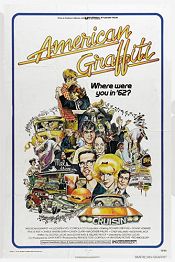 (sometimes gravely) the rest of the good, honest, paying
customers. Oliver Stone chose the diner as the location for
Mickey and Mallory’s murderous coming-out party location in
1994’s Natural Born Killers. As truckers, those with
mischief or murder on the mind, those who have nowhere else
to go, or those who simply need a coffee or some bacon,
gather and mingle many violent climaxes have been reached in
American cinema history. The Diner, American Graffiti, and
Pulp Fiction all used the diner as a location, and in seldom
few films was it a pleasant one. They are usually motionless
places of regularity, with Hopper-like nighthawks
frequenting them throughout the night. Yet, every so often
they are the witness to explosive levels of rage and
violence, after all what better place to announce your
criminal intent to the town than in the modern day version
of the Wild West salon: The Diner.
(sometimes gravely) the rest of the good, honest, paying
customers. Oliver Stone chose the diner as the location for
Mickey and Mallory’s murderous coming-out party location in
1994’s Natural Born Killers. As truckers, those with
mischief or murder on the mind, those who have nowhere else
to go, or those who simply need a coffee or some bacon,
gather and mingle many violent climaxes have been reached in
American cinema history. The Diner, American Graffiti, and
Pulp Fiction all used the diner as a location, and in seldom
few films was it a pleasant one. They are usually motionless
places of regularity, with Hopper-like nighthawks
frequenting them throughout the night. Yet, every so often
they are the witness to explosive levels of rage and
violence, after all what better place to announce your
criminal intent to the town than in the modern day version
of the Wild West salon: The Diner.
Ennio Morricone Musico!
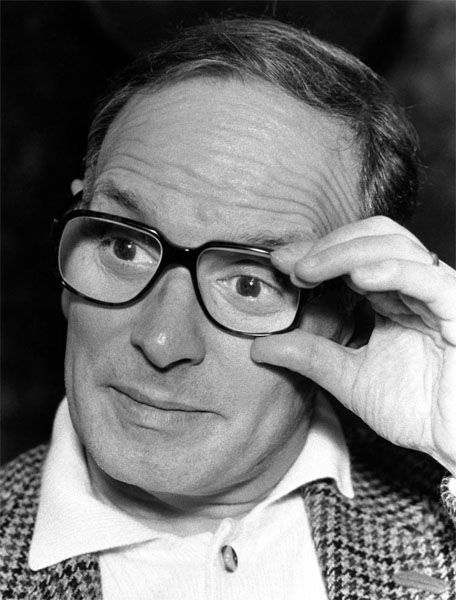 Ennio
Morricone was born in Roma in 1928, and can, some 80 years
later, be considered a man who changed not just his niche of
the film industry (music), but also the production of movies
in general. His scores, perhaps more so than any other
composer, show us how much music can add to movies. His
influence spreads far and wide, from Eastwood to Metallica,
who are said to start their shows with an instrumental of Il
Buono, il brutto, il cattivo’s ‘The Ecstasy Of Gold’.
Intensity, humor, suspense and drama; all aspects which
amplify when Morricone assembled the music. He arranged the
music behind many of the Spaghetti Westerns, especially
those of school friend Sergio Leone, yet also took time out
to emphasize his w Ennio
Morricone was born in Roma in 1928, and can, some 80 years
later, be considered a man who changed not just his niche of
the film industry (music), but also the production of movies
in general. His scores, perhaps more so than any other
composer, show us how much music can add to movies. His
influence spreads far and wide, from Eastwood to Metallica,
who are said to start their shows with an instrumental of Il
Buono, il brutto, il cattivo’s ‘The Ecstasy Of Gold’.
Intensity, humor, suspense and drama; all aspects which
amplify when Morricone assembled the music. He arranged the
music behind many of the Spaghetti Westerns, especially
those of school friend Sergio Leone, yet also took time out
to emphasize his w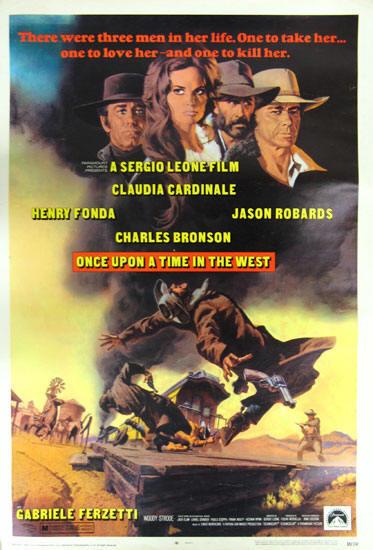 ork
in other genres: “I'm not linked to one genre or another. I
like to change, so there's no risk of getting bored.” ork
in other genres: “I'm not linked to one genre or another. I
like to change, so there's no risk of getting bored.”
Within his field he is greatly appreciated, as needs
require. In his long career, he has received many awards:
the Golden Lion and the Honorary Oscar, among which 8 Nastri
D’argento, 5 Baftas, 5 Oscar Nominations, 7 David Di
Donatello, 3 Golden Globes, 1 Grammy Award and 1 European
Film Award. In the 2009 the President of the French
Republic, Nicolas Sarkozy, has signed a decree giving him
the rank of Knight in the Order of the Legion of Honor. If
we fail to recognize Morricone’s genius, we may fail to see
how much a musical score can add to a film. Even silent
films, many of which are shown today with musical
accompaniment, can benefit from music.
Of all the genres, it is horror that benefits most from
music. The sounds can be used not only to build suspense as
the inevitability of the killing becomes apparent, but also
to add to the intensity of the climatic killing. Dario
Argento’s Suspiria is filled for the first half hour with a
plethora of peculiar sounds, all of which add to the nervous
feeling the viewer has, when they know that someone will
surely die. Perhaps then it is a shame that Morricone was
not so involved in horror movies. Regardless, his legacy as
a musician and film contributor will life on eternally, and
hopefully be added to in the coming years.
JIMMY STEWART: AMERICA’S ACTOR
 Jimmy
Stewart is one of America’s best-loved and finest actors.
His career spanned nearly 60 years, and included a wide
variety of roles. He can be regarded as a Western star, a
leading man in thrillers, or as the quintessential American
family man. His amiability on screen was equaled off screen
where he was an impressively decorated veteran, and pioneer
for black and white films. Jimmy
Stewart is one of America’s best-loved and finest actors.
His career spanned nearly 60 years, and included a wide
variety of roles. He can be regarded as a Western star, a
leading man in thrillers, or as the quintessential American
family man. His amiability on screen was equaled off screen
where he was an impressively decorated veteran, and pioneer
for black and white films.

He held the highest active military rank of any actor in
history. During World War II, he served in the Army Air
Corps and rose to the rank of colonel. This bravery as a
soldier was not matched by some of his more “macho”
co-stars, in particular John Wayne, who has a reputation as
a recruitment dodger.
One image that is easy to picture is of Stewart and best
friend Henry Fonda settling down to their favorite activity
of silently painting model airplanes together.
In this day and age of actors who more frequently makes
us roll our eyes than inspire us; Stewart would be a simple
and welcome change. He was liked in many sectors of society,
for example Former President Harry S. Truman, who was once
quoted as saying that if he had a son, he would want them to be just
like “just like Jimmy Stewart;” and while always gracious
with his fans, he was always very protective of his privacy.
A notable example of this occurred when a nervy family of
tourists set up a picnic on his front lawn. Stewart came out
of his house and, without uttering a word, turned on the
sprinklers. It is nice that an actor of such talent didn’t
have the pretensions to match: “I'm the inarticulate man who
tries. I don't really have all the answers, but for some
reason, somehow, I make it.”
saying that if he had a son, he would want them to be just
like “just like Jimmy Stewart;” and while always gracious
with his fans, he was always very protective of his privacy.
A notable example of this occurred when a nervy family of
tourists set up a picnic on his front lawn. Stewart came out
of his house and, without uttering a word, turned on the
sprinklers. It is nice that an actor of such talent didn’t
have the pretensions to match: “I'm the inarticulate man who
tries. I don't really have all the answers, but for some
reason, somehow, I make it.”
Film taglines
Film taglines are still used today, but only a few
studios
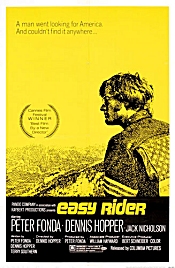 appreciate
their importance in film history, and appreciate how much we
need and love them. It takes a good tagline to hearken back
to a film, or to "reinforce that one iconic image. " If
creative, they can be powerful tools of advertisement. This
Monthly Feature recalls some of my personal favorites, and I
hope that by doing so; I can speak to the continued
importance of this niche of film advertising. appreciate
their importance in film history, and appreciate how much we
need and love them. It takes a good tagline to hearken back
to a film, or to "reinforce that one iconic image. " If
creative, they can be powerful tools of advertisement. This
Monthly Feature recalls some of my personal favorites, and I
hope that by doing so; I can speak to the continued
importance of this niche of film advertising.
Some are
great because of their simplicity, and ability to sum up a
film in one line:
1.
"Crushed lips don't talk." ('I Confess')
2. "Check in. Relax. Take a shower."
('Psycho')
3. "The film that will satisfy every over-sexagesimal
adult." ('Orgy of the Dead')…what, even moi?
4. "Being the adventures of a young man
whose principal interests are rape, ultra-violence and
Beethoven." ('A Clockwork Orange')
5. "Pathetic earthlings, who can save you
now?" ('Flash Gordon')…or Jack Bauer.
6. "They're tobacco chewin', gut chompin',
cannibal kinfolk from hell." ('Redneck Zombies')…bet you'll
rush out a see this film!
Yet other films choose to be
suggestive instead, trying to entice potential viewers with
peculiar statements, which generate more questions than
answers: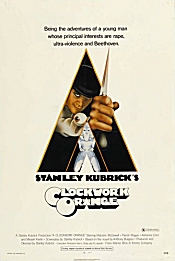
7. "From the moment they met, it was
murder." ('Double Indemnity')
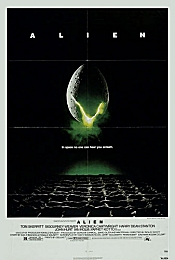 8.
"A man went looking for America and couldn't find it
anywhere." ('Easy Rider') 8.
"A man went looking for America and couldn't find it
anywhere." ('Easy Rider')
9. "This was the weekend they didn't play golf."
('Deliverance')…this film must be the best advertisement for
golf ever.
10. "In space no-one can hear you scream."
('Alien')…classic!
11. "Does for Rock and Roll what 'The Sound
of Music' did for hills." ('This is Spinal Tap!")
And now, because I'm very
self-important, my all time favorite:
"Hombre means man. Paul Newman is Hombre."
('Hombre')
Voyeurism: The Next
Level Of Creepiness
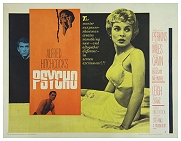 In
1960, Alfred Hitchcock and Michael Powell were two
of Britain’s most prominent filmmakers. Their
projects that year, although similar in theme and
content, received wildly opposing reactions from
moviegoers. ‘Peeping Tom’ sent Powell’s career into
a tailspin, rendering his earlier classics, ‘The Red
Shoes’ (1948), ‘Black Narcissus’ (1947), and ‘The
Thief of Baghdad’ (1940), as nothing more than
distant memories. ‘Psycho’, on the other hand, was a
commercial success, and Hitchcock went on to create
even more success stories. In
1960, Alfred Hitchcock and Michael Powell were two
of Britain’s most prominent filmmakers. Their
projects that year, although similar in theme and
content, received wildly opposing reactions from
moviegoers. ‘Peeping Tom’ sent Powell’s career into
a tailspin, rendering his earlier classics, ‘The Red
Shoes’ (1948), ‘Black Narcissus’ (1947), and ‘The
Thief of Baghdad’ (1940), as nothing more than
distant memories. ‘Psycho’, on the other hand, was a
commercial success, and Hitchcock went on to create
even more success stories.
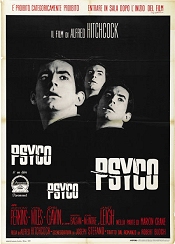 Not
many like to be watched, but most like to watch.
Voyeurism alone is an unnerving phenomenon, but when
a filmmaker explores it, the creepiness reaches new
levels. Filmmakers’ dealing with voyeurism is
disturbing enough, given that they spend half their
lives behind cameras, watching. But when Alfred
Hitchcock and Michael Powell explored it in 1960
they went one step further; by inserting themselves
and their audiences into the mind of a voyeur, they
forced voyeurism as an issue. Not
many like to be watched, but most like to watch.
Voyeurism alone is an unnerving phenomenon, but when
a filmmaker explores it, the creepiness reaches new
levels. Filmmakers’ dealing with voyeurism is
disturbing enough, given that they spend half their
lives behind cameras, watching. But when Alfred
Hitchcock and Michael Powell explored it in 1960
they went one step further; by inserting themselves
and their audiences into the mind of a voyeur, they
forced voyeurism as an issue.
Hitchcock’s fascination with this phenomenon can
be seen in earlier films such as ‘Rear Window’, but
in ‘Psycho’ he chose to use a 50 mm lens on his 35
mm camera, which I am told, gives a closer
representation of human vision; thus enabling his
viewers to take part in the voyeuristic exploits of
Norman. We are unnerved upon meeting Anthony
Perkins’ character because of his eerie smile and
peculiar hobby of taxidermy (stuffing birds), but we
only find out about his sinister motives when he
peers through a hole in the wall at his motel
guests. In other words, we become enthralled by, and
afraid of Norman Bates, only when we learn he is a
voyeur.
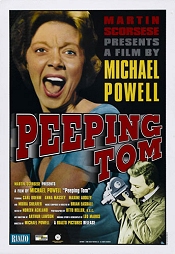
Powell, far more disturbingly, used his family in
‘Peeping Tom’s’ bizarre home-movies: his wife plays
‘the successor’ to Mark’s mother, and his real-life
son plays the young Mark. In fact, Powell himself
plays the character of Mark’s Father, the most
voyeuristic and disturbing of all the film’s
players, and every camera that the film’s lead uses
is marked with the name ‘Michael Powell’, linking
the director to both members of the film’s
voyeuristic Father and Son duo. Although both
directors are interested in voyeurism, it is perhaps
this heightened level of personal inclusion by
Powell that makes ‘Peeping Tom’ that much more
unsettling. It could even be suggested that it was
this that prompted the film’s initial commercial
failure and controversy. Regardless, both films
offer an interesting insight into voyeurism, and do
so not by stepping back and observing it as a
psychological phenomenon, but rather by engrossing
the film in it, and exploring their own voyeuristic
fantasies, for us to observe.
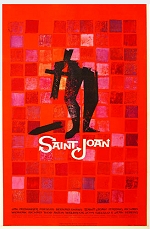 Saul
Bass Saul
Bass
The style imprint of Saul Bass can still be seen
today in modern commercial advertising and graphic
design alike. The Art Director’s Club notes how
“it's virtually impossible for any North American to
pass through a day without encountering a Bass
design, artifact or image.” Granted, his title
sequences are rightly what he is renowned for, but
his contribution to movie poster has not gone
unnoticed, and he can easily claim to have changed
the art of film advertising and posters forever.
 The
abstract, crooked hand, which the Half Sheet for
“The Man With The Golden Arm” centers around, is not
only striking, but also somewhat revolutionary. For
many years leading up to it, it was the stars that
were captured in the poster, and it is Bass whom we
are indebted to for this change. The
abstract, crooked hand, which the Half Sheet for
“The Man With The Golden Arm” centers around, is not
only striking, but also somewhat revolutionary. For
many years leading up to it, it was the stars that
were captured in the poster, and it is Bass whom we
are indebted to for this change.

Rather
than a poster glorifying the star, Frank Sinatra, we
have a work of graphic art. His influence has been
felt ever since in the world of movie posters,
inspiring an alternative approach to film marketing,
based more on aesthetics than reputation.
Perhaps his best design work comes in the US-One
Sheet for ‘Anatomy of a Murder’, where his
abstraction extends from the arm to the whole body,
giving an image that hearkens, in every beholder,
thoughts of criminal acts, crime cinema, and,
perhaps most importantly, graphic design: moving
movie posters one step closer to that much
sought-after title of ‘art’.
Gadget-Man Stan: The Use of
Machines in Kubrick’s Dr. Strangelove and 2001: A Space
Odyssey
 While
watching these two Kubrick classics the thing that stood out
for me was the long, detailed shots of machines. The
emphasis put on machines in Dr. Strangelove shows how
powerless man had become over what is man-made at that time
in history. Or, as Dr. Strangelove puts it the machines had
been designed to “rule out human meddling,” which in the end
leads to our total destruction. Ironically, with all those
gadgets General Ripper believes the Russians are poisoning
the water, an ancient way to bring-down societies. Further,
with all the gadgets available, man is still unable to
benefit from them because of their own failings. Captain
Mandrake struggles to use the phone to call the president
because of a suspicious officer, and the destroyed radio on
the Maj. Kong plane makes it impossible to recall the order
to fire on the Russians. While
watching these two Kubrick classics the thing that stood out
for me was the long, detailed shots of machines. The
emphasis put on machines in Dr. Strangelove shows how
powerless man had become over what is man-made at that time
in history. Or, as Dr. Strangelove puts it the machines had
been designed to “rule out human meddling,” which in the end
leads to our total destruction. Ironically, with all those
gadgets General Ripper believes the Russians are poisoning
the water, an ancient way to bring-down societies. Further,
with all the gadgets available, man is still unable to
benefit from them because of their own failings. Captain
Mandrake struggles to use the phone to call the president
because of a suspicious officer, and the destroyed radio on
the Maj. Kong plane makes it impossible to recall the order
to fire on the Russians.
Kubrick juxtaposes marveling in the beautiful majesty and
complexity of the machines, and showing how dangerous the
machines can potentially be. It seems to me that Kubrick was
at that time almost having an experience of numinous: he is
fascinated by the intricacy of the machines, but fears their
consequences. Regardless, like a mystic he must portray this
phenomenon that surrounds and confronts him and the 1960s
audience. Although the conversation between the two world
leaders shows how far we have come technologically, in that two people from opposing sides of the worlds can
speak as if face-to-face, but also shows how useless all
that technological development is if the people who are
using them are foolish, or drunk!
in that two people from opposing sides of the worlds can
speak as if face-to-face, but also shows how useless all
that technological development is if the people who are
using them are foolish, or drunk!
Timothy E. Scheurer sums up the relationship between man
and machine in 2001 by saying: "For all the science,
technology, and intellectual speculation about the
future…they are still primarily concerned with the human
condition and the reaffirmation of our humanity...Science
fiction traditionally has also been a site where the belief
in progress (especially scientific of technological
progress) comes up against a distrust of the very same
science and technology."
Perhaps the climax of this tense relationship comes not
as the world ends in Dr., since man is still somewhat to
blame there, but as 2001 ends with a computer that can
reason and destroy without the meddling of man. This may
well be Kubrick’s ultimate fear, as a machine is humanized
in the form of HAL 2009, with the calm, collected, but
moreover eerie voice of Douglas Rain. Kubrick shows us how
complex the machines are, but how easy it is for us fallible
human beings to suffer because of them.
|
|
|